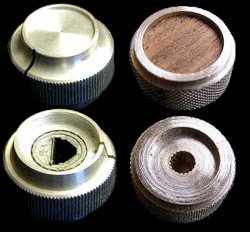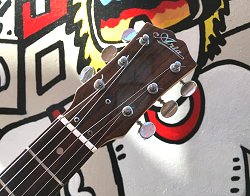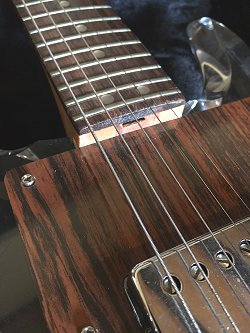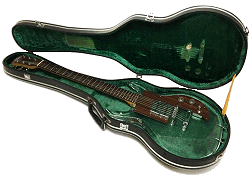
The Aria SK Skeleton guitar model seen at upper left has features that will be seen on
many copy brands of the Dan Armstrong guitar models. However, it's somewhat ironic that said features are really nothing like the original Ampeg
models for as seen here this 1971 model sports a larger faux-wood scratchplate that - for lack of better words - 'wraps around' the pickups.
Unfortunately, one thing very much like the original Dan Armstrong scratchplate is breakage - in and around the output jack, which can be seen
here. In the enlarged view, notice a dark 'ring' around the output jack. This 'ring' is the result of a raised section, or 'patch' added to the
scratchplate, for reinforcement - and very likely, just to have something to mount the jack onto.
At upper right, and seen from the backside, another difference. Instead of a one piece quarter sawn maple neck on the original Dan Armstrong
model the Aria features a 3-piece laminated maple neck - separated by two thin dark strips, probably mahogany - that extends the entire length
of the neck and up through the headstock. The base of the neck is bolted to the acrylic body in the same fashion as the guitar it's copied after
- using chrome plated carriage bolts. However, unlike the original Dan Armstrong neck there is much less mass that makes up the neck's tongue
that gets seated into the body. Unfortunately, less mass means less stability... specifically, tuning stability. But, being a dual pickup guitar
model there simply wasn't enough space and a sacrifice had to be made.
Also, notice the channel running from the control pocket straight over to the cavity routed for the ball end of the strings - and then to the
tailpiece. No doubt for grounding purposes, it's without a doubt the cleanest version of grounding I've seen on these copy instruments.
At upper left & right, the stock pickups on the Aria are identical to those employed by many other badged named instruments, including models
from Commodore, Cort, Raven, Shaftesbury and Univox. Most, if not all of the pickups were supplied by Maxon. Not surprisingly these pickups look
somewhat like Dan Armstrong pickups - in that they have bar type pole pieces. However, unlike the original Dan Armstrong pickups - these units
sport chrome plated metal covers, giving the pickups the look of a humbucker - yet they are single coil. Perhaps the covers help shield the
pickups more, to reduce hum.
At upper left, and seen better in enlarged view, the Aria name can be seen on the headstock. Like the original Dan Armstrong model this
instrument features a 24 fret rosewood fingerboard with dot position markers with double dots at the 12th and 24th frets.
Unlike the original, this fingerboard has a dot on the first fret. Also, the dot position markers on the Ampeg Dan Armstrong instruments are
much smaller, measuring in at 3mm. The markers on this and most other copy instruments of the time are much larger.
At upper right, another Aria Dan Armstrong copy. Notice that these instruments feature a tailpiece like those equipped on the original Ampeg
models. However, the rosewood saddle is shaped differently, more like those seen on many of the Danelectro guitar models.

|
Equally different from the original Dan Armstrong models are the volume & tone knobs which, although shaped somewhat close to the original Ampeg
styled knobs these knobs feature circular wooden inserts on the top.
At the lower right, notice how the copy knobs are fashioned for a fully rounded potentiometer shaft, whereas the Ampeg knobs (seen at left) are
made for only ½ of a shaft and therefore have more of a 'D' shape.
|
At upper left, an Aria Dan Armstrong copy with an interesting rosewood bridge. On the right, and from the back, very clean routing
of the control cavity can be seen.
At upper left and right, a closer look at the body.
At left, a closer look at the split style bridge, while at right the original knobs and switch.
At left, notice the top screw holding the truss rod cover in place is unlike the bottom two screws. On the right, the original
tuners adorn the headstock.
Another Aria model, advertized as an Aria Pro. The Aria brandname was changed from Aria - to Aria Pro II in late 1975. Often shortened to
just 'Aria Pro' by musicians, it was on auction while I was updating these pages. At upper left, notice the holes in the body below the
bridge. It would seem to appear that this instrument was once equipped with a surface mount tremolo bar. Seen better in enlarged view,
notice the large, square cavity that was routed for the dual humbucking sized pickups.
At right, the original bridge/tailpiece has been replaced with what appears to be a 'string-thru' type adjustable unit. While I asked for a
photo of the rear of the body to see the 'string-thru' alterations my request was declined. From what I can tell, three of the four screws that
secure the unit down appear to be sheet rock type screws. In the enlarged view, the tailpiece grounding wire can be seen entering the control
cavity.
More noticeable is the tongue of the neck. As mentioned in the auction, the laminations of the neck in, and around this area were separating and
were glued back together. The good news is that this seems to be contained within the confines of the channel that was routed in the acrylic
body for the neck, and which should help hold the laminations together. Given the confines of this routed channel, the wonder is how the
separations even began.
At upper left, the rosewood fingerboard sports medium sized frets, while above right, the 3-piece laminated maple neck gets bolted
to the acrylic body. Notice the dark shim added at the end of the neck.
Above left, the Gibson styled 'open-book' headstock got updated with a set of replacement tuners of higher quality. Unfortunately the faux-wood
veneer gets damaged in the process which can be seen in and around some of the tuner posts. This type of headstock can be seen across many of
the Dan Armstrong badged copies. The faux-wood truss rod cover is equally ubiquitous.
At the upper right, and seen from the backside, the screw holes from the original tuners are left unplugged, while at the center of the
headstock, what is apparently some left over adhesive still remains. Most likely this is from a musical store label that was applied years ago.
Above left, and set against what looks like a 1960s style backdrop, an Aria Dan Armstrong copy with a replacement 'tortoise' looking
scratchplate. Likely the original suffered the usual breakage that occurs when one steps on their guitar cord. At right, and seen from the
backside, the clear acrylic not only looks clean, but flawless for an instrument from this era. Notice that this model, unlike the Aria models
above, feature a tunomatic style bridge.

|
Like the rest of the instrument the headstock appears to be in mint condition - up to, and including the original tuners.
|
Above left, an Aria Dan Armstrong copy in mint condition save for a replacement selector switch. At right, another change is the control cavity
and back of the scratchplate which has been shielded to reduce hum, no doubt as a result of the instrument being equipped with single coil
pickups.
Above left another Aria model with a tuno-matic style bridge and replacement pickups, seen here resting in its case. At right, and seen against
a brighter backdrop, the body appears to be in immaculate condition. All photos are courtesy of Randall Crocker.
Above left, although you'd never know it, the original scratchplate has been replaced after the 'usual' breakage that occurs on these
instruments. When asked, Randall replied "I had the scratchplate copied from the original plate as a template and cut it out using a router.
However, it has a glossy finish to it, not like the matt finish of the original Dan Armstrong scratch plates." Notice too, that the
original knobs have been replaced with a pair that nicely matches the other chrome plated hardware surroundings.
At right, and seen better in the enlarged view, this instrument features an H T F brand tun-o-matic style bridge with metal
saddle pieces. H T F apparently supplied bridges of the same style on many of the MIJ golden-era copies as I'm seeing them on
other badged guitars from this time frame as well, though some are supplied with nylon saddle pieces.

|
The Aria, like the Raven and Univox copies have a unique feature at the end of the tongue on the maple neck as there is a routed channel that
can be seen under the fingerboard.
I can only speculate that this channel is for the truss rod at this end of the neck.
|
On the left, and ironically, the wood veneer on the headstock of the Aria has a glossy finish to it. So the glossy replacement scratchplate actually turned out to be
a rather nice match to the headstock. At right, and seen from the back, the laminated neck and headstock sports the original tuners.
At left, a mint condition Aria Dan Armstrong copy rests in its factory case. Notice that this one is also equipped with a tun-o-matic style bridge and stop type tailpiece.

|
As seen at left, a full shot of the Aria in its case. Not surprisingly, the case is of the same type used by many of the Japanese guitar
makers of the time.
|
According to The Guru's Guitar Guide by Tony Bacon & Paul Day, Aria is a brandname of the Aria company with most of their
70's guitars being copy instruments made by Matsumoku. Aria instruments were imported and distributed
by NHF Musical Merchandise Inc. in Pennsaken, NJ.
copies menu
main menu
Names and images are TMand © Dan Armstrong / Ampeg. All rights reserved.
All other names and images are TMand © of their respective owners. All rights reserved.
|
| |

